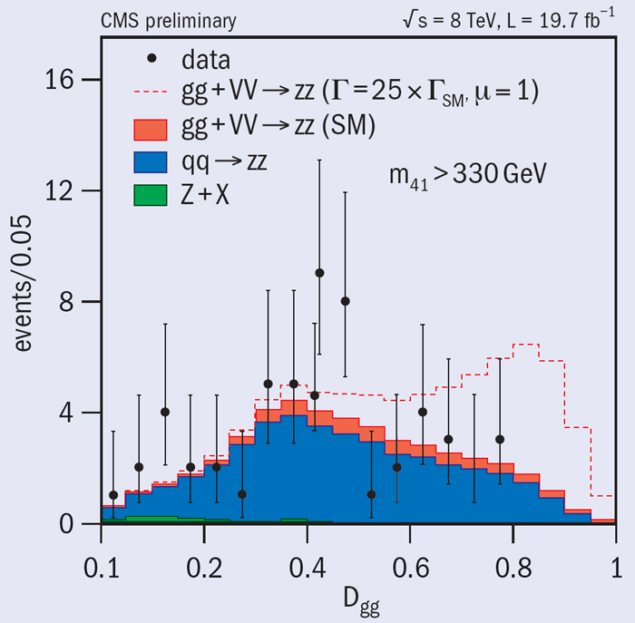After the discovery of a Higgs boson at the LHC in 2012, all of the measurements of its properties and tests of its spin-parity have proved to be consistent with the predictions of the Standard Model. One important property is its natural width, which is expected to be small in the Standard Model – approximately 4 MeV. A larger width could indicate, for example, additional non-standard Higgs decays into known or unknown particles.

At the 2014 Rencontres de Moriond in March, the CMS collaboration presented new and stronger constraints on the total width of the 125 GeV Higgs boson by applying a novel technique on the data collected at the LHC at a centre-of-mass energy of 8 TeV. Following suggestions from several theorists to measure the ratio of the production rate for Higgs-mediated ZZ events with a mass considerably above the mass of the resonance (larger than approximately 200 GeV) to that on the peak, it is possible to derive precise indications on the maximal size of the Higgs boson’s natural width. For this analysis, CMS exploited two ZZ decay channels of the Higgs boson: H → ZZ → 4 leptons, where the four leptons can be electrons or muons, and H → ZZ → 2 leptons + 2 neutrinos.
To maximize the sensitivity of this analysis, in the 4-lepton channel, CMS took advantage of the kinematic differences between 4-lepton production occurring through gluon–gluon fusion (as for Higgs production) and through quark–antiquark scattering, which constitutes a large background to this analysis. The collaboration employed a matrix-element likelihood discriminant Dgg similar to that used for the standard Higgs analysis to help separate signal from background, and carried out a simultaneous fit of this discriminant versus the 4-lepton mass to measure the cross-section for off-peak production. The figure shows the distribution of the discriminant Dgg for events with high mass.
The 2 lepton + 2 neutrino channel has the advantage of a larger branching ratio, but it comes at the price of more background: owing to the presence of neutrinos, the final state is not fully reconstructed. This channel is based on the presence of large missing transverse energy (MET), and therefore is only sensitive to the off-shell part of the cross-section. In the case of on-peak production, the Z decaying into neutrinos does not have large transverse momentum and does not generate a significant MET. The on-peak cross-section measured from H → ZZ → 4 leptons is used for both channels.
The final result of the analysis is that the two channels have very similar sensitivities. In the Standard Model scenario, each of them is expected to exclude at the 95% confidence level (CL) a Higgs-boson width about 10 times larger than the natural width predicted by the model. The combined result is an exclusion of 17 MeV (35 expected) at 95% CL, which corresponds to 4.2 (8.5 expected) times the width in the Standard Model. Previous direct limits obtained from the measured width of the H → ZZ and H → γγ peaks, which are dominated by the detector resolution, are much weaker (of the order of a few giga-electron-volts).





